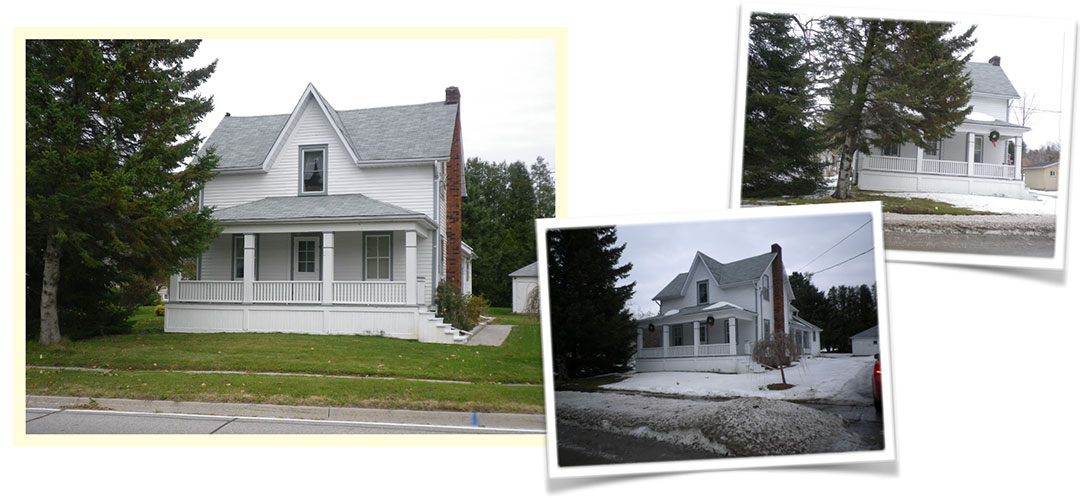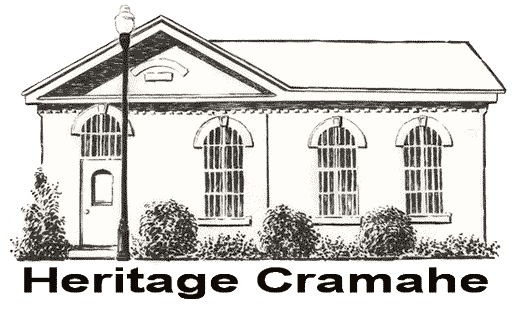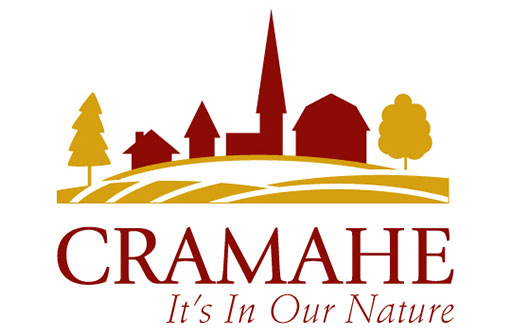50 Toronto Street, Colborne
(1880s)
Roll No. 1411-012-010-07100 – Cramahe Township Ontario

Gothic Revival Cottage
It sits on Toronto Street, which is Highway No. 2, the original York/ Kingston route in the early 19th century. Typically, the Ontario cottages of Northumberland County are classic one and a half story or two, Gothic revival architecture.
They have a steep central gable in the half story, and many are enhanced with a small upper story balcony, not so in this case. Also, many of these properties have very fancy bargeboard and a large finial (see Chestnut Lawn at 101 King Street East in Colborne) but this property is defined by its simplicity, without ornamentation other than contrasting paint around the windows and doors. There is a rear “tail” and a porch which offers shelter for the side/back
door. There is a very substantial porch on the front facade, which runs across the entire width of the house and there is a large chimney in the gable end.
History or Associative Value
Joe Keeler, M.P. sold the property to John Male, a carpenter who, with his wife Fanny and nine children lived in Cramahe from 1851 to 1881. Their son William bought the property from his parents in 1881, and in 1895 William’s estate sold to William H. Edwards, a Colborne cooper (barrel maker). An archive photo shows the W.H. Edwards business sign on a building across from Victoria Square. A sharp increase in the price during William Male’s ownership probably means a house was then present.
Additional Historical and Genealogical Information
Nathaniel Gaffield (ca. 1755-ca. 1838) was the first owner of Concession 2, Lot 32, a 200 acre parcel part of which would later become Reid Lot 33. To read more about Nathaniel Gaffield, … (LINK). Lot 32 is bounded on the south by King Street West, and on the north by Orchard and Purdy Roads. On the east it is bounded by the undeveloped road allowance running north from Ontario Street. On the west the southern half of the Lot is bounded by Percy Street. Percy Street angles northwestward in the northern half of Lot 32, and the western edge of the lot is along the line Percy would have taken if it had headed straight north.
Although he had probably lived there since at least 1797, Gaffield wasn’t officially granted Lot 32 until 13 May 1804. He sold it to Joseph Keeler (1763-1839) on 23 January 1806. For more on the Keeler family… (LINK).
Keeler transferred the southern third of Concession 2, Lot 32 to his son Joseph Abbott Keeler (1788-1855) on 1 January 1824. This was the area now bounded by Ontario Street on the west, Percy Street on the east, and King Street on the south. The northern limit was along the backs of the modern properties along the north side of Park Street.
Over the next 30 years Joseph Abbott Keeler sold off bits and pieces of this land to a variety of people. On 28 September 1854 he transferred most of what was left of his property in this area to his son Joseph Keeler III (1824-1881).
Joseph Keeler III continued his father’s tradition of selling off lots. On 9 April 1872 he sold Reid Lots 33 and 34 to John Male (ca. 1814-?). Male was a carpenter who appears in Cramahe censuses from 1851 through 1881. His wife was Fanny Wilson (1821-?) and censuses list nine children: George (1844-?), William W. (1846-?), Benjamin (1848-?), Fanny Elizabeth (1850-1922), Francis (1855-?), Frederick James (1861-?), Dolby (1868-?), Mary S. (1868-?), and Elizabeth (1872-?).
On 19 November 1881 John and Fanny Male sold lots 33 and 34 to their son William W. Male. His occupation was listed as printer in 1871 and bartender in 1881. In both censuses, he was still living with his parents. No reference has been found to wife or children.
William Male died sometime around 1895 because on 20 November of that year the executors of his estate sold Reid Lot 33 to Colborne cooper William H. Edwards (1869-1935). His name, as “W. H. Edwards 1908”, appears on the façade of one of the buildings facing the east side of Victoria Park. He married Elizabeth B. Lowe (1870-?) in 1892 and had, as far as can be determined, one child: Myrtle May (1893-?).
On 8 March 1900 William Edwards transferred title to Lot 33 to his wife and on 28 March 1903 she sold it to George Arthur Edwards (ca. 1877-?), retaining Lot 34 until 1910 when she sold it to Joseph Williams. Lot 33 remained in the Edwards family until 1952. George Edwards was William Edwards’ brother. He married Emma Wilmot Turpin in 1898 and had three children: Pearl Irene (1900-?), Vera (1902-?), and George H. (1910-?). Like his brother, he was a cooper.
William Male purchased Reid Lots 33 and 34 for $100 in 1881 and the executors of his will sold them to William Edwards for $450 in 1895. Edwards transferred them to his wife for $1 in 1900. Elizabeth Edwards sold Lot 33 without Lot 34 to her brother-in-law for $500 in 1903. All of these transactions other than the one between William Male and William Edwards were between family members, so the sale prices may not be very predictive of land value. Nevertheless if we ignore that, the 450% increase in value during the tenure of William Male might be taken as possible evidence of improvement (house construction?). Similarly, the sale from Elizabeth to George Edwards of Lot 33 exclusive of Lot 34 for more than her husband had paid for the two lots combined might also be taken as an indication of improvement. Elizabeth Edwards sold Lot 34 in 1910 for only $115, suggesting that the house on the property was probably on Lot 33.
All of the owners of Reid Lot 33 are potential candidates for residence there. No particular evidence has been found to suggest that any of them lived elsewhere at the time they owned the property. The only solid evidence available for residency is the 1911 census which places George Edwards and family there that year.




